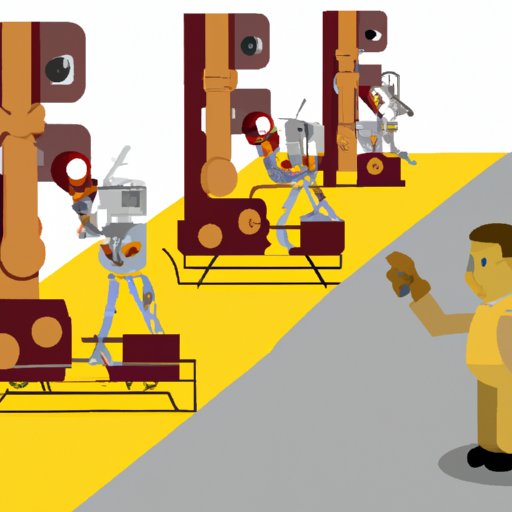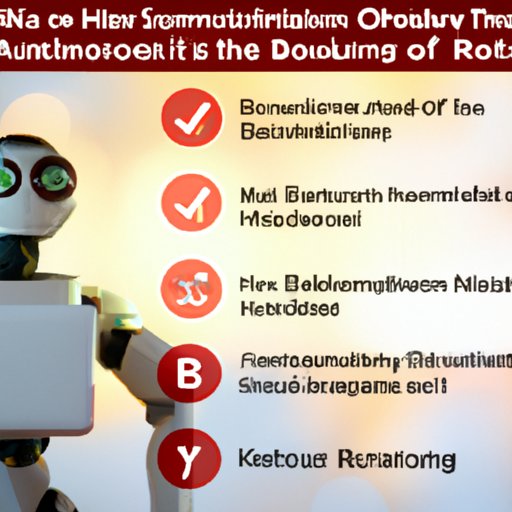Introduction
Robotics automation is a technology that uses robots to automate processes and reduce human labor. Robots have been used in industrial settings for decades, but recent advancements in robotics technology have enabled them to be used in a wider range of applications. This article will explore what robotics automation is, its history, benefits, challenges, and the future of robotics automation.
The History of Robotics Automation
Robots have been used in factories since the 1950s, when George Devol invented the first programmable robot. Since then, robots have become increasingly sophisticated and capable of performing complex tasks. In the 1980s, robots began to be used in assembly lines as well as in other industrial processes. In the 1990s, robotic arms were developed that could perform intricate tasks with precision and accuracy.
In the 2000s, robots became even more advanced, with the introduction of artificial intelligence and machine learning. Today, robots are used in a wide range of applications, from manufacturing to service industries. They are also being used to automate mundane tasks, such as customer service and data entry.

The Benefits of Robotics Automation
Robotics automation offers many benefits to businesses, including improved efficiency, cost savings, increased accuracy, and reduced labor costs. By automating routine tasks, businesses can save time and money, freeing up resources for other activities. Additionally, robots can perform tasks with greater accuracy and precision than humans, resulting in higher quality products and services.
Robots also require less maintenance than their human counterparts, making them cheaper to operate in the long run. Furthermore, robots do not require wages or benefits, which can lead to significant cost savings for businesses. Finally, robots can help reduce workplace injuries, since they are not prone to human error.
The Future of Robotics Automation
Robotics automation is continuing to evolve at a rapid pace. Technological advancements are allowing robots to become smarter and more capable of performing complex tasks. As robots become more sophisticated, they will be able to take on more difficult roles in the workplace, such as customer service and data analysis.
Robotics automation is likely to become even more prevalent in the coming years, as businesses look to reduce costs and increase productivity. In addition, the use of robots in the workplace may help to create new jobs, as businesses look to develop and maintain their robotic workforce.

Challenges and Limitations of Robotics Automation
Despite the many benefits of robotics automation, there are still some challenges and limitations. The initial cost of purchasing and setting up robots can be high, and the complexity of programming robots can be daunting. Additionally, safety concerns must be taken into consideration, as robots can cause injury if not properly monitored and maintained.
Types of Robotics Automation
Robotics automation can be divided into three main categories: industrial robotics, service robotics, and collaborative robotics. Industrial robots are used in factories and warehouses to automate repetitive tasks such as welding and assembly. Service robots are used in customer service and other service-oriented roles, and collaborative robots are designed to work alongside humans in the workplace.

How to Implement Robotics Automation in Your Business
Implementing robotics automation in your business requires careful planning and consideration. First, you should identify areas where automation can be beneficial. You should then analyze the cost versus benefit of implementing a robot solution. After that, you should choose an appropriate robot for the task, and train employees on how to use it safely and effectively.
Finally, you should monitor the performance of the robot to ensure it is meeting your expectations. Regular maintenance and updates should also be performed to keep the robot running smoothly. By taking these steps, you can ensure that your robotics automation implementation is successful.
Conclusion
Robotics automation is an increasingly popular technology that can help businesses improve efficiency, reduce costs, and increase accuracy. There are a number of benefits and challenges associated with robotics automation, and it is important to understand these before implementing a robotic solution in your business. With careful planning and implementation, robotics automation can be a powerful tool for businesses of all sizes.
(Note: Is this article not meeting your expectations? Do you have knowledge or insights to share? Unlock new opportunities and expand your reach by joining our authors team. Click Registration to join us and share your expertise with our readers.)
